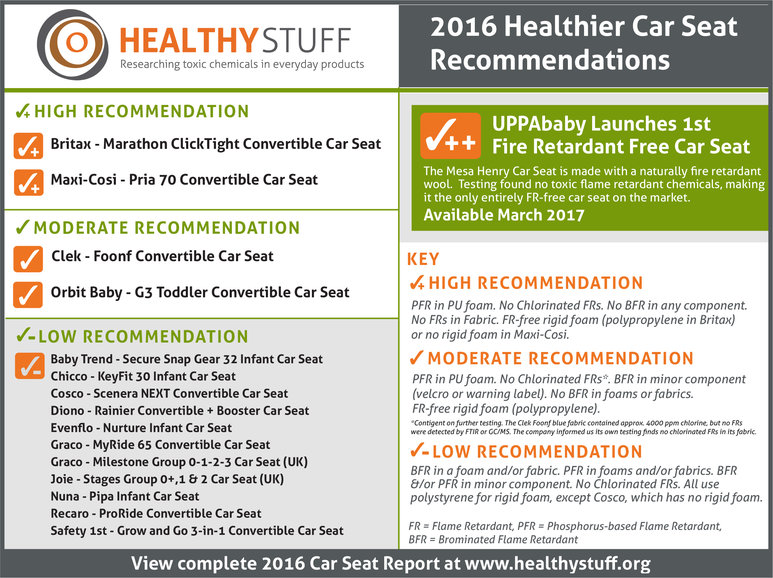The trend for chemicals in car seats is going in the right direction. We have seen phase outs of some brominated and chlorinated FRs and an increase in the use of halogen-free FRs. This is the second consecutive study in which we haven't found any PBDEs (polybromintated diphenyl ethers, which are known endocrine disruptors) and the first year there were no chlorinated flame retardants, such as chlorinated tris (a known carcinogen).
However, the textile fabric of car seats is still flush with brominated flame retardants (BFRs). In fact 13 of the 15 seats (87%) contain BFRs. The Maxi Cosi and Britax seats did not contain any BFRs; the Clek and Orbit seats only contained them in the smaller components such as warning labels or Velcro, not in fabrics or foams. This is concerning, as brominated chemicals are typically persistent, bioaccumulative, and often toxic, in some cases carcinogenic.
Phosphorus-based, halogen-free FRs were detected in all 15 seats. Eliminating halogens is important, but even halogen-free FRs must be carefully studied for health hazards. Some of the phosphorus FRs found in 2016 seats may pose a lower hazard, but we found health-related data to be lacking. And one halogen-free FR, triphenyl phosphate, has known health concerns.
Encouraging news this year came from a manufacturer whose seat was not officially included in the 2016 study: UPPAbaby. The Mesa “Henry” seat will be available early in 2017 and is highly anticipated as the first known infant car seat to forego FR chemicals and rely on naturally fire-resistant wool to achieve flammability standards.

What’s a parent to do?
Here’s our advice regarding car seats and the car environment as a whole—because every surface and material in the car itself is likely coated or infused with flame retardant chemicals.
- Contact the car seat companies. Let them know you expect them to manufacture products without toxic chemicals, which threaten the health of our children and natural resources. Car seat companies need to hear from people like you. They need to know we are tired of toxic chemicals being added to our children’s products, and demand safer, healthier options.
- Limit the time your children spend in their car seats. Only use the car seat during travel, not as a place for your child to nap or sit outside of the car.
- Limit direct sunlight on the car seat and high temperatures in your car. Flame retardants and other hazardous chemicals may be released at a higher rate when your car becomes hot. When possible, park in the shade or in covered parking. Window coverings in a car also substantially lower the interior temperature on a warm day.
- Vacuum the car interior and the nooks and crannies of car seats. Chemicals that migrate out, including flame retardants, can cling to dust particles. Open the car windows when possible.
- If you’re looking to purchase a car seat, we suggest you look for companies that have comprehensive chemical policies—ask if you can’t find the information easily—or a system to prioritize reduction and elimination of toxic chemicals in their products. Companies that sell children’s products should publicly disclose these policies. While HealthyStuff.org cannot test every car seat for every chemical of concern, here’s our general advice: buy the safest car seat you can afford and use it only for travel, support companies that publicly prioritize healthier, non-toxic products and, most importantly, enjoy your journey through parenthood!
What should companies do?
- HealthyStuff.org urges companies to prioritize the manufacturing of safer, healthier products by adopting the Five Essential Practices for Retailers, Brand Owners and Suppliers. These five practices emphasize company-wide policies on reducing hazardous chemicals in their products, chemical disclosure to consumers, as well as phasing out the most toxic chemicals and transitioning to safer alternatives.
- Companies who adopt these five essential practices are likely to bolster their consumers’ confidence, trust and loyalty to their products. Consumers, especially parents, are demanding safer, healthier options for their families. Companies can capitalize on this demand by adopting these five essential practices and ensuring their products are free from the most toxic chemicals.
- With regard to chemical flame retardants, we urge companies to choose the least toxic options available, to use as little as needed to meet the fire test standard, and to re-evaluate the materials and added chemicals in their seats on a regular basis as new research becomes available.
- We further suggest that companies design the seat covers on car seats to be easily removed for laundering. Washing the covers can remove contaminated dust and other particles. Most current car seats must be significantly dismantled in order to remove the covers, making regular laundering impractical.


